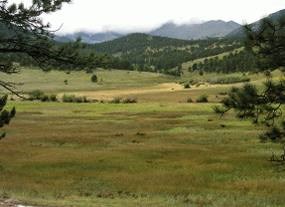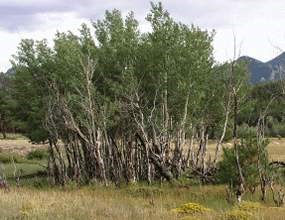
NPS Photo Elk & Vegetation Management Plan Fact Sheet-July 2011 Elk, (Cervus elaphus) or wapiti, are native to the Rocky Mountain National Park area, and have lived in the vicinity for thousands of years. However, by the 1870s, heavy and unregulated hunting had eliminated elk in the area. Around 1900, wolves, the only significant predator of elk in the area, had also disappeared. Elk were reintroduced to the area in 1913 and 1914, shortly before Rocky Mountain National Park was established in 1915. In the absence of both significant predation and hunting, the elk population in the park flourished. By the early 1930s, elk numbers had increased to the point that National Park Service (NPS) managers expressed concern about deteriorating vegetation conditions on the elk winter range. Starting in 1944, the elk population using the park was limited primarily by having rangers cull the herd (kill elk by shooting). To a lesser degree, trapping and transplanting also were used to control elk numbers. For the next 25 years, the number of elk using Rocky Mountain National Park was maintained between 350 and 800 animals. In 1969, a natural regulation policy involving no active management within the park was instituted. It was believed that hunting in adjacent areas would control the elk population in and near the park. 
NPS Photo Since the implementation of the natural regulation policy, elk numbers have continued to increase and vegetation changes have been observed, particularly a decline in willow and aspen on the elk's primary winter range. The appropriate elk population size, and associated effects on plant communities and biodiversity, have been increasingly questioned. In 1994, a research initiative aimed at gathering critical information needed to provide a scientific basis for a management plan was started. Results from those and all other pertinent scientific studies will be used in developing the plan. Elk are a major attraction for visitors to Rocky Mountain National Park and Estes Park. Each year thousands of people come to enjoy viewing elk and listening to the bulls bugle in late summer and early fall. While the presence of elk in the park and on lands throughout Estes Park is a majestic sight, there are concerns. Property damage and human safety concerns in Estes Park have increased as elk increasingly use parks, golf courses, and yards in close proximity to people
Chronic wasting disease (CWD), a fatal brain disease known to affect deer and elk, has been detected in elk within Rocky Mountain National Park. The National Park Service is looking at ways to address the problem. Although the elk and vegetation management plan will not specifically evaluate alternatives for managing chronic wasting disease, the strategies and objectives of the plan will identify ways to determine the prevalence of CWD in the park and be consistent with CWD management both inside and outside of the park.
|
Last updated: February 24, 2015
